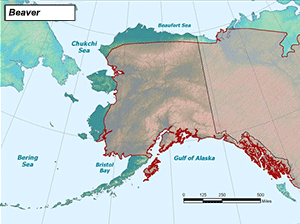- Castor canadensis
- pajuqtaq, aqu
- aqsatuyak, aqsatuyaaq, paluqtaq, ceńiq’aq,
- s'igeidí, s'ikyeidí


Pacific beaver (Castor canadensis leucodenta) - are found along the Coast Ranges from California to Alaska.
Suitable habitat for American beavers must contain all of the following: stable aquatic habitat providing adequate water; channel gradient of less than 15 percent; and quality food species present in sufficient quantity.
Adult American beavers are non-migratory.
American beavers can usually control water depth and stability on small streams, ponds, and lakes. Large lakes or reservoirs (20 acres in surface area) with irregular shorelines provide optimum habitat for the species.Lakes and reservoirs that have extreme annual or seasonal fluctuations in the water level are generally unsuitable habitat for American beavers. Intermittent streams or streams that have major fluctuations in discharge will have little year-round value as American beaver habitat.
Stream characteristics such as gradient, depth, and width are determining factors in habitat use by American beaver. Steep topography prevents the establishment of a food transportation system. Additionally, narrow valley bottoms cannot support the large amounts of vegetation needed by American beavers. Consequently American beaver populations in narrow valley bottoms are more cyclic than are populations in wider valley bottoms. Valleys less than 150 feet (46 m) wide are occupied less frequently. One study found that 68 percent of the American beaver colonies recorded in Colorado were in valleys with a stream gradient of less than 6 percent. No American beaver colonies were recorded in streams with a gradient of 15 percent or more. Valleys that were only as wide as the stream channel were unsuitable American beaver habitat, while valleys wider than the stream channel were frequently occupied by American beavers.
Food availability is another factor determining suitable habitat for American beavers. Marshes, ponds, and lakes are often occupied by American beavers when an adequate supply of food is available. American beavers generally forage no more than about 300 feet (90 m) from water; however, foraging distances of up to 656 feet (200 m) have been reported. The lodge is the major source of escape, resting, thermal, and reproductive cover for American beavers. Lodges may be surrounded by water or constructed against a bank. Water protects the lodge from predators and provides concealment for American beavers when traveling to and from food gathering areas and caches. On lakes and ponds, lodges are frequently situated in areas that provide shelter from wind, waves, and ice. Damming large streams with swift, turbulent waters creates calm pools for feeding and resting.